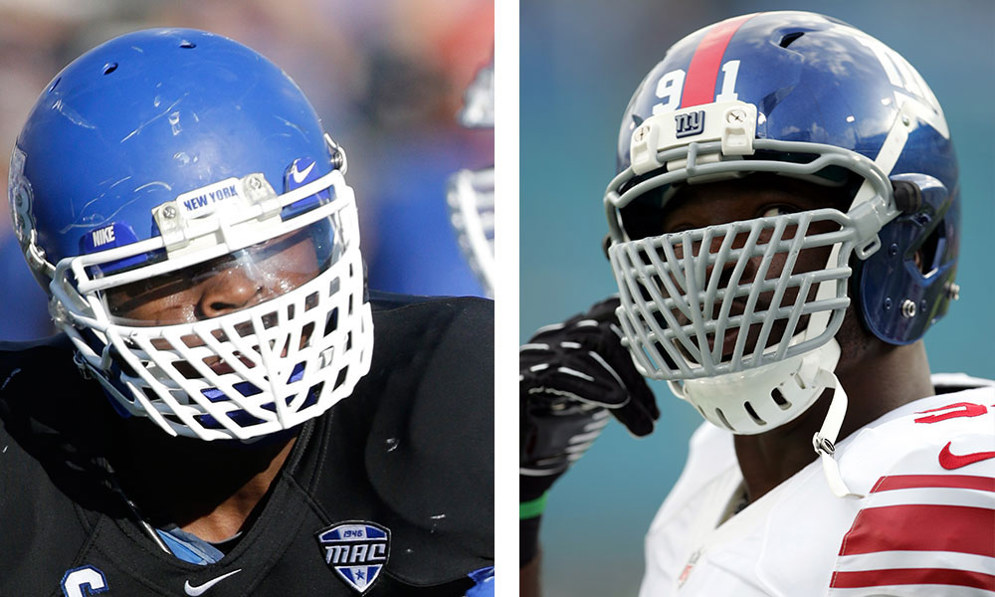Uniform Inspections
Protecting players and maintaining competitive equity on game days.
Protecting players and maintaining competitive equity on game days.
These days, he scans the field as one of the NFL’s 64 uniform inspectors — former players assigned to a team’s home games to ensure that both clubs comply with the league’s uniform rules.
Morris starts roaming the field at Giants home games during warm-ups, keeping a close watch for violations. When the league mandated thigh and knee pads as a protective measure, for example, he had to make sure that players were actually using them.
“What I’m trying to do is from my eye, my naked eye, I have to be able to discern that there’s a thigh [pad] and knee [pad] there and I have to be able to see it clearly,” Morris told the NFL Network’s “Around the League” program in 2013.
“A lot of guys don’t like it,” he said, referring to the pad requirement. “This is a good rule. It’s sensible. It’s trying to protect the players.”
Compliance with the uniform rules helps the league to protect players from injury, maintain competitive balance, create a professional appearance and protect the league’s business partnerships.
As an example, for the 2014 season the NFL banned the use of nonstandard or “overbuilt” face masks unless players can prove the need for a medical exemption from the rules. Research shows that the added weight negatively affects the helmet’s structural integrity and fatigues the neck extensors, potentially putting players at risk for injury.

The NFL denied Khalil Mack’s request to continue using the “overbuilt” face mask he wore in college but granted Justin Tuck’s request for a medical exemption, so he can keep wearing his. (AP Photo/Mike Groll) (AP Photo/Paul Jasienski)
If a player suffers from migraines or is sensitive to sunlight, he’ll need a medical exemption to put a tinted visor on his helmet as a replacement for the permitted clear visor. The restriction isn’t arbitrary; at times, medical personnel need to see an injured player’s eyes without removing his helmet, and tinted visors interfere with that.
“A player’s appearance on the field conveys a message regarding the image of the league and directly affects the league’s reputation and success,” the NFL’s Game Operations Manual states. All players must tuck in their jerseys. They cannot wear bandannas. Stockings must be white from the top of the shoe to midcalf and an approved team color from midcalf to the bottom of the pant leg, which must be pulled down below the knee.
To maintain fairness among all 32 teams and their players, the NFL banned tear-away jerseys in 1979 so runners couldn’t use them to escape tackles. Kicking shoes cannot be modified. Players cannot wear headgear or any other equipment or apparel that in the opinion of the uniform inspector or the referee may confuse an opponent because its color is similar to a football’s.
The NFL’s rules regarding the equipment that players can wear during games, minicamps, training camps and practice sessions ensure the apparel’s quality. For example, the NFL’s Foot and Ankle Subcommittee tests different shoes for durability and flexibility and recommends to players those it feels are the most comfortable and most durable.
Inspectors also protect the NFL’s commercial agreements: Only logos or brand names from the league’s official partners can be displayed.
Players may wear other brands, as long as they remove or cover the name or logo. For example, NFL compliance vice president Akil Coad said, if a player chooses to wear specially molded shoes from a company that isn’t an official league partner, “who are we to tell them not to wear it? Just don’t show the mark.”
The uniform inspector’s job is to make sure that every player in violation of the rules is aware of it and has an opportunity to correct it. He’ll talk directly to players and, a half-hour before kickoff, he’ll meet with a team representative to report problems. That employee must bring any player spotted with a violation back to the inspector for clearance before kickoff.
The inspector’s job doesn’t end after warm-ups; he notifies teams of any violations he spots during a game as well. Players and teams have the opportunity to get into compliance at the next change of possession or other “appropriate stoppage” in play. After the game, the inspector roams the locker rooms, checking to make sure that no nonpartner logos can be seen by reporters, fans or television cameras — and then writes a summary of each game for the league.
For many violations, a player cannot go back into the game until the problem is corrected. Teams can be penalized 5 yards if — after receiving a warning — the player enters the game anyway. Failing to comply with league warnings can result in hefty fines.
Most players quickly and willingly come into compliance. All fines collected go directly to funds that benefit former players.